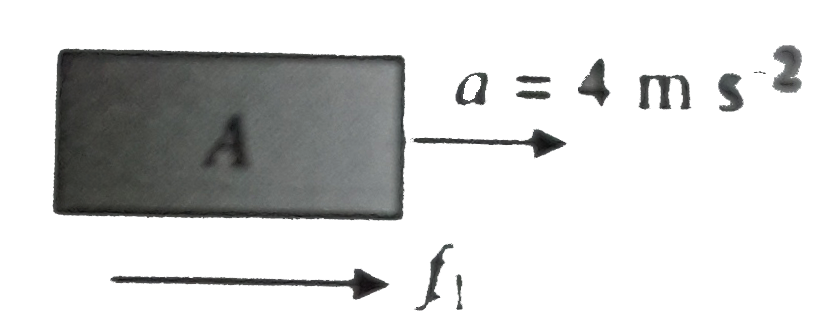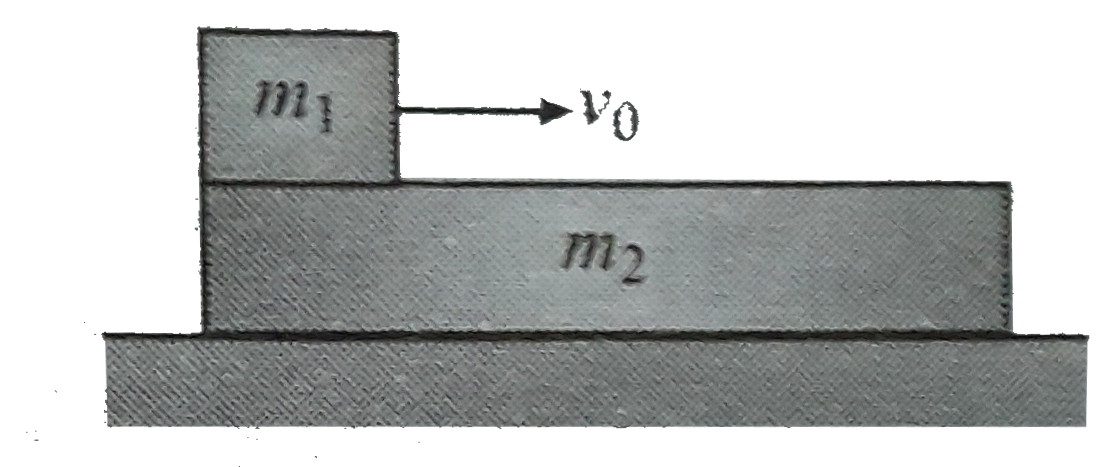In the sitution shown in figure there is no friction between 2kg and ground.

a. For what maximum value of force F can all three blocks move together?
b. Find the value of force F at which sliding starts at other rough surfaces.
c. Find acceleration of all blocks, nature and value of friction force for the following values of force F (i) 10N (ii) N and (iii) 25N
Friction between blocks AandB
fl1=fk1=0.5×1×g=5N
Friction force between blocks B and C
fl2=fk2=0.2×(1+2)×g=6N
maximum posible accceleration of blocks A can be
aA,max=0.5g=5ms−2
Maximum posible accceleration of blocks C:
aC.maxfl22=62=3ms−2
For the entire system to move together, we have to take lesser ecceleration
a. Maximum force F that can be applied for the entire system to move togather : Fmax=mtotala
⇒Fmax=(1+2+2)×3=15N
b. Sliding will start between blocks B and blocks C if F>15N

For sliding to start between blocks A and blocks B : This will accur when acceleration of combined blocksA and blocks B will exceed5ms−2
F−fk2_=(mA+mB)a
F−6=(1+2)×5⇒F=21N
c. i F=10N<15N , so entire system will move together with common acceleration

a=101+2+2=2ms−2
Friction between blocks B and blocks C
f2=2a=2×2=4N
Friction between blocks A and blocks B
f1=1×a=1×2=2N
ii . F=18N, here 15N<F<21N, so sliding start between blocks B and blocks C and not between blocks A and B

Acceleration of blocks C
a=−fk2/m=6/2=3ms−2
Acceleration of blocks A and B
a=18−61+2=4ms−2 Friction between blocks C and ground is
fk2=6N
Friction between blocks A and B:
f1=1×4=4N

iii F=25N>21N, so sliding occure at all the contact surface friction between blocks A and B is fk1=5N 
Friction between blocks B and C is fk2=6N
Accelerations of blocks A and B are their maximum possible acceleration
Acceleration of block B :
a=25−5−62=7ms−2
Topper's Solved these Questions
- NEWTON'S LAWS OF MOTION 2Book:CENGAGE PHYSICS ENGLISHChapter:NEWTON'S LAWS OF MOTION 2Exercise:Exercise 7.1
Explore 25 Videos
- NEWTON'S LAWS OF MOTION 2Book:CENGAGE PHYSICS ENGLISHChapter:NEWTON'S LAWS OF MOTION 2Exercise:Exercise 7.2
Explore 16 Videos
- NEWTON'S LAWS OF MOTION 2Book:CENGAGE PHYSICS ENGLISHChapter:NEWTON'S LAWS OF MOTION 2Exercise:Integer type
Explore 1 Video
- NEWTON'S LAWS OF MOTION 1Book:CENGAGE PHYSICS ENGLISHChapter:NEWTON'S LAWS OF MOTION 1Exercise:Integer
Explore 5 Videos
- PROPERTIES OF SOLIDS AND FLUIDSBook:CENGAGE PHYSICS ENGLISHChapter:PROPERTIES OF SOLIDS AND FLUIDSExercise:INTEGER_TYPE
Explore 2 Videos
Similar Questions
A block weighing 20N rests on a horizontal surface . The coefficient of static friction between the block and surface is 0.4 and the coeffiecient of kinetic frictioni 0.20
a.How much is the friction force excerted on the block?
b. How much will the friction force be if a horizontal force of 5N is exerted on the block?
c. What is the minimum force that will start the block in motion ?
d. What is the minimum force that will keep the block in motion once is has been started ?
e. If the horizontal force is 10N what is the friction force?
View SolutionA block of mass 1kg is horizontal thrown with a velocity of 10ms−1 on a stationary long of mass 2kg whose surface has a μ=0.5. Plane rest on friction surface find the time when m1 comes to rest w.r.t. plane

View SolutionA block is moving on an inclined plane making an angle 45∘ with the horizontal and the coefficient of friction is μ. The force required to just push it up the inclined plane is 3 times the force required to just prevent it from sliding down. If we define N=10μ, then N is
View SolutionA block is placed on an inclined plane moving towards right horizontally with an acceleration a0=g. The length of the plane AC=1m. Friction is absent everywhere. Find the time taken (in seconds) by the block to reach from C to A.

View SolutionTwo soap bubbles A and B are kept in aclosed chamber where the air is maintained at pressure 8Nm2. The radiiof bubbles A and B are 2cm and 4 cm , respectively. Surface tension of the soap-water used to make bubbles is 0.04 N/m. The ratio of nB/nAis ( where nA and nB are the numbe of moles of air in bubbles A and B,respectively.)
[Neglect the effect of gravity]
View SolutionThere are two block as shown in the figure of masses 1kg and 4kg . Friction coefficient between any two surfaces are 0.2 then find maximum value of horizontal force F so that both blocks moves together.
View SolutionWhat is the maximum value of the force F such that the block shown in the arrangement, does not move?

View SolutionIn the sitution shown in figure there is no friction between 2 kg and ground. a. For what maximum value of force F can all three blocks move together? b. Find the value of force F at which sliding starts at other rough surfaces. c. Find acceleration of all blocks, nature and value of friction force for the following values of force F (i) 10N (ii) N and (iii) 25 N
View SolutionThe coefficient of friction between the blocks are mu_(s) = 0.3 and mu_(k) = 0.2 . (a) Find the maximum value of F so that the blocks move together. (b) If force F is twice the value found in (a) , find the acceleration of each block.
View SolutionFind value of pulling force F for which block just moves. Given coefficient of friction for surface is μ.

View Solutionएक क्षैतिज सतह पर m तथा M द्रव्यमान के दो गुटके विरामावस्था में स्थित है| गुटके एक डोरी द्वारा बँधे है और दाहिने गुटके को क्षैतिज बल F द्वारा खिंचा जा रहा है| m=2kg,M=4kg तथा μ1=μ2=0.4 माने| g का मान 10m/s2 माने| (a) यदि F का मान 4N हो, तो क्या आप रस्सी का तनाव तथा दोनों गुटकों पर घर्षण बल का मान बता सकते है|
(b) मान लें, प्रारम्भ में डोरी में तनाव शून्य और F का मान शून्य से धीरे-धीरे बढ़ाया जाता है| द्रव्यमान M पर लगनेवाले घर्षण बल के मान और F के बिच ग्राफ खींचे|ऐसा ही ग्राफ m पर लगनेवाले घर्षण बल F के बिच खींचे|
(c) F के किस मान के लिए गुटके फिसलने लगेंगे?
View SolutionWhat is the maximum value of the force F such that the block shown in the figure does not move?
View SolutionTwo blocks A and B are lying on the table as shown in the figure. The coefficient of friciton between block A and block B is mu . The coefficient of friction between block B and ground also mu . An external force F is applied in the direction shown. The maximum value of the force F that can be applied without moving the blocks.
View SolutionThere are two block as shown in the figure of masses 1kg and 4kg. Friction coefficient between any two surfaces are 0.2 then find maximum value of horizontal force F so that both blocks moves together.
_2019_CBT6_E01_036_Q01.png)
View SolutionFind the maximum value of friction force between the blocks shown in the diagram if both are oscillating together with amplitude A on smooth horizontal surface.
View Solution